New Chromatography Columns and Accessories at Pittcon 2012, Part I
LCGC North America
A review of columns unveiled at Pittcon this year, including all modes of HPLC, UHPLC, and liquid-phase separations.
Part I of our yearly report on new products introduced at Pittcon. This month, columns are highlighted, covering all modes of HPLC, UHPLC, and liquid-phase separations.
Pittcon 2012 (more formally known as the 63rd Pittsburgh Conference on Analytical Chemistry and Applied Spectroscopy) returned to the Orange County Convention Center in Orlando, Florida, from March 11 to 15, 2012 after a one year absence. This year's event hosted 948 instrument manufacturers and laboratory suppliers in 1854 booths. In addition to attending the exposition, conferees listened to more than 2000 technical presentations (orals, posters, workshops, invited and contributed talks, and award symposia), checked on numerous company seminar rooms, or attended one of 95 short courses.
Although the average attendance has been shrinking over the last several years, undoubtedly, Pittcon still remains the most important yearly international analytical exhibition where companies introduce their latest instruments, instrument accessories, software, columns, sample preparation, and other consumable products. Because many past attendees have purchased one or more new products within three months after attending the show, most exhibitors attempt to maximize their booth traffic to meet as many potential customers as possible.
The purpose of this report is to provide information about many of the new separation consumables and accessory products that were displayed at Pittcon 2012. In some cases, products that were introduced during 2011 but after Pittcon 2011 (1,2) may be included for reasons of completeness. The information is based on manufacturers' responses to a questionnaire mailed in early 2012. Because of space limitations and the fact that some manufacturers did not respond to the questionnaire, this report cannot be considered an exhaustive listing of all new products that were introduced since last year's event in Atlanta. However, over the years, these Pittcon introduction summaries have provided a good source of information that would be difficult for one individual to gather during the four days of the exhibition. In addition, the products introduced have shown definite correlations to current research, development, and application activity in the separation sciences.
As in previous years, columns and other products recommended by their manufacturers primarily for biomolecule separations or sample preparation are denoted in the tables with the designation BIO. Some of these products may be used for general high performance liquid chromatography (HPLC) separations as well, but their main emphasis is for biological samples.
In this month's coverage, I describe new column introductions in the areas of HPLC, reversed-phase chromatography, normal- and bonded-phase chromatography, flash chromatography, supercritical fluid chromatography (SFC), ion-exchange and ion chromatography, size-exclusion chromatography, hydrophilic interaction chromatography (HILIC), and specialty chromatography. Next month, I will look at gas chromatography (GC) columns, thin-layer chromatography, sample preparation products, and hardware, accessories and small tabletop instruments, mainly for sample preparation.
Trends and Highlights
General: This year, I observed a continuing trend in high-throughput chromatography driven by dramatic increases in chromatographic efficiency, especially in HPLC and ultrahigh-pressure LC (UHPLC). But as chromatographic efficiency becomes exploited to the ultimate, more focus is now directed toward improved selectivity with mixed-mode separations, new bonded-phase development, and application-specific separation products. In addition, the introduction of more products with inert surfaces driven by increases in instrument sensitivity especially through increasing use of tandem mass spectrometry (MS) techniques in both GC and LC. The development of systems with more inert flow paths, newer deactivated packing materials, deactivated surfaces such as fused-silica columns, vials, and GC injection liners are all being addressed to improve recovery of very low levels of analytes.
In HPLC, there was a further increase in columns and accessories designed to work with UHPLC. Many application-specific columns for HPLC and GC tested with "real world" samples before shipment were noted. Again at Pittcon, a considerable number of new accessories, hardware, and devices were introduced to make the chromatographic laboratory more productive.
HPLC columns: Pittcon 2012 saw the introduction of more sub-2-µm columns for UHPLC, additional superficially porous particles (SPP, also known as core–shell particles) and the second generation of silica monolith columns, giving users alternative approaches for high-throughput and high-efficiency separations. UHPLC has established itself as a viable solution to today's separation problems; at least nine major instrument vendors now address this market with instruments capable of operation at pressures as high as 19,000 psi. This year, even more HILIC columns appeared for the separation of polar compounds weakly retained or unretained by reversed-phase HPLC. Still, reversed-phase HPLC maintained its dominance. Application-wise, chiral columns, protein (particularly monoclonal antibody) columns, and ion chromatography–ion exchange columns dominated.
Column stability and lifetime issues are being addressed by newer UHPLC columns and column hardware, new approaches to chemical bonding, and more polymeric and hybrid columns with high-pH capability.
GC and SFC columns: GC column introductions were dominated by high-temperature columns and columns with new levels of inertness. SFC has been getting more attention; this "intermediate" separation technique is catching on, especially in the pharmaceutical area. Packed SFC columns are more like HPLC columns but have some unique phases not found in a typical LC laboratory.
Sample preparation: Sample preparation products for automation, such as 96-well filtration and solid-phase extraction (SPE) plates, seem to be in vogue. Higher stability phases with lower levels of bleed, particularly for mass spectrometric work, were prevalent. Mixed-mode phases are getting more popular in SPE and HPLC as well. Combinations of molecular interactions such as hydrophobic and ion exchange can often enhance analyte isolation. QuEChERS (quick, easy, cheap, effective, rugged, and safe) methods are still "catching on" as the favored sample preparation technique for pesticides in fruits and vegetables. Dried blood spotting products are beginning to appear as more pharmaceutical companies are investigating these devices to replace traditional blood handling.
Accessories: More than 40 new hardware products and accessories for HPLC, UHPLC, GC, and sample preparation were noted. UHPLC-specific products with higher-pressure ratings and with decreased dead volumes were introduced. A number of automated sample preparation instruments or instrument accessories contribute to minimizing the labor-intensiveness and drudgery of manually preparing samples for chromatography. This year, a number of workstations that do some (but not all) of the sample preparation steps were evident.
New Series of HPLC Columns and Packings
Each year, manufacturers introduce entire new families of HPLC columns at Pittcon. For the sake of brevity, I have elected to cover those series here instead of listing each column under individual headings in the tables. In some cases, the series are extensions of existing products but cover additional phases, whereas in other cases the families are entirely new to the market.
New series of HPLC columns were shown by several companies (Table I). Because these series offer a wide range of particle sizes (from UHPLC to preparative) that are made by the same process and chemistry, seamless scaleup and scaledown within a family is possible. Method development can be performed on a short, fast analytical column and then can be scaled up to preparative dimensions with easy method transfer. Most introductions of new series included both sub-2-µm and larger particles.
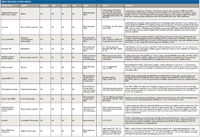
Table I: New series of HPLC columns
In ion chromatography, larger particles (5 µm and larger) and analytical–microbore columns have been the norm. This year, Dionex, now part of the Thermo Fisher Scientific company, introduced capillary ion chromatography columns with a 0.4-mm internal diameter packed with 4-µm ion-exchange particles. The capillary column format provides lower mobile-phase consumption because flow rates are reduced proportionally based on radius ratios squared and the mass sensitivity is increased (assuming the same sample mass is injected). The 4-µm particles give an improved efficiency over the larger particles. Figure 1 shows a 2.5-min separation of simple inorganic anions using a 4-µm IonPac AS18 cartridge column (150 mm × 0.4 mm) at a flow rate of 30 µL/min. Conductivity was used for detection.
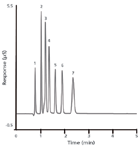
Figure 1 (Courtesy of Thermo Fisher Scientific.)
It seems that UHPLC is here to stay. Most new column series will have at least one column with sub-2-µm particles. The obvious advantage of such small particles is better column efficiency so that shorter columns can be used to accomplish the same separation achieved on a longer column. The end result is that separation times are greatly decreased in proportion to the column length reduction. In addition, a shorter column with the same internal diameter that is run at the same flow rate saves a proportional amount of solvent, always important these days with the cost of everything on the rise.
The introduction of SPP columns continues with the entry of new companies and more phases from existing suppliers. These columns have caught on not only with those who have older 6000-psi systems but also with those using UHPLC systems. The columns have the efficiency of the sub-2-µm columns with about half of the pressure drop when comparing the same dimensions. Three of the new companies with the addition of new SPP column product lines are ChromaNik Technologies of Osaka, Japan, PerkinElmer of Waltham, Massachusetts, and Thermo Fisher Scientific from Runcorn, United Kingdom, bringing the total number of companies with such columns to eight.
Reversed-Phase Chromatography
As usual, many new reversed-phase chromatography columns were introduced at Pittcon 2012 (see Table II). If one also adds all the columns capable of reversed-phase interactions covered in the new series (Table I), in the HILIC category (Table III), and in specialty columns (Table IV), one can clearly see the dominance of this operational mode. This Pittcon added more than 69 new reversed-phase chromatography columns to the huge numbers that already existed from past introductions. Silica-based bonded phase columns dominated the introductions again this year (~90%) but polymer-based, organic–silica hybrids, and a silica hydride columns were also on the scene.
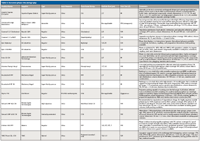
Table II: Reversed-phase chromatography
The C18 (octadecylsilane) functionality proved again to be the most popular with 30% of all reversed-phase chromatography columns being this alkyl phase. However, this phase isn't always the optimum for all separations and a great number of other hydrophobic stationary phases were introduced. Besides the normal C8, C4, and phenyl phases, C18 with mixed functionality (such as phenyl and diisopropyl sterically protecting groups), phenyl-hexyl, fluorophenyl, diphenyl, embedded polar, propyl pentafluorophenyl (PFP), cyanopropyl, cholesteryl, naphthylethyl, AQ (which tolerate highly acqueous mobile phases), and graphitized carbon phases were made available by various suppliers to present selectivity alternatives. An interesting mixed-mode phase consisting of PFP and C18 also was introduced. The HILIC columns that have some hydrophobic interaction possibilities are found in the "specialty column" section (Table III).

Table III: Columns for HILIC separations
In keeping with the trend noted in the last few Pittcons, Table II shows a number of introductions of small particle columns in the 2-µm and sub-2-µm range, often referred to as UHPLC columns. There are now more than 25 manufacturers of these high-efficiency porous particle columns. It is almost expected now that new columns should provide at least one sub-2-µm particle size in the portfolio.
At Pittcon 2012, besides the families introduced (listed in Table I), additional SPP columns for the reversed-phase chromatography mode were displayed (Table II). As pointed out earlier, these columns show the same efficiency as the sub-2-µm columns but at half of the back pressure. To balance the shift to these columns, several companies introduced porous particle columns with particle size in the 2–3 µm range. These columns aren't as efficient as the sub-2-µm columns but are more efficient than the popular 3.0–3.5 µm columns. In addition, they show a lower pressure drop than the sub-2-µm columns but a higher drop than the 3.0–3.5 µm columns.
In recent years, there has been a trend in introductions of bonded silica-based columns with wider pH limits. Most bonded phase silicas are recommended to be used in the pH 2–8 range. At low pH (<2), the bonded phase, especially those with short chain lengths, will hydrolyze, leaving behind bare silica. Consequently, retention times will generally change and peak tailing becomes a big problem. At high pH (>8), the silica gel itself will begin to solubilize, which is dependent on the solvent, type of buffer, and temperature. By bonding carbon phases with sterically protecting groups, with high coverage of long alkyl groups, or by coating the silica with polymeric material, the pH range can be extended. By using organo–silica hybrid chemistry, bidentate bonding, and polymer coatings or polymer encapsulation, the range can be further extended to pH 1–12. This year, columns with an extended range of pH stability using some of these principles were introduced. Of course, polymeric columns have an even wider range but still don't rival silica-based columns in terms of efficiency.
Monolithic columns have shown promise for many years but have been unable to displace the traditional microparticulate columns. The silica monoliths have been around for over a decade but the introduction of the second generation monoliths may change their acceptance. Merck KgaA and its U.S. affiliate Millipore EMD have introduced the Chromolith High Resolution columns that display 50% higher efficiency than the first generation. Merck has accomplished this by further optimization of the mesopore/macropore ratio of the monolith at the price of a slightly higher pressure than the first generation monolith. However, because one of the attributes of the monoliths is their low pressure drop, this increased pressure in not much of a disadvantage. Figure 2 shows a comparison of the new Chromalith High Resolution C18 endcapped monolith column with one of the popular SPP columns using the same chromatographic conditions and column dimensions. Note that the pressure drop of the monolith is less than half of the pressure of the SPP column. An improvement in tailing factors over the first-generation version, especially with basic compounds, is also a positive attribute of the second-generation monolith columns.

Figure 2
Normal-Phase Chromatography
Normal-phase chromatography implies that a nonpolar mobile phase and a polar stationary phase are used for the separation. Although normal-phase chromatography is not used nearly as much as reversed-phase chromatography, there are instances when the technique can offer advantages. For example, for water-sensitive compounds the technique is ideal because totally organic solvents are used. Also, for certain geometric isomers and cis-trans isomers are well separated by normal phase but sometimes are more difficult to resolve by reversed-phase chromatography. This year, two companies introduced columns with functional groups well suited for normal-phase separations. The Waters Xselect HSS Cyano column can be used in normal-phase solvents as well as reversed-phase solvents. In reversed-phase mode, it behaves as a short-chain material with some moderate polar functionality. In our last column survey (3), this was the predominant use of cyano phases. On the other hand, it serves as a good normal-phase column when used with organic solvents. The cyano column is prepared with a monofunctional silane with diisopropyl groups surrounding the –CN group, which gives it better stability in acid solution. Columns are available with 1.8-, 2.5-, 3.5- and 5-µm particles with scaleability among all the particle sizes. Columns are available with 20–250 mm × 1.0, 2.1, 3.0, and 4.6 mm dimensions.
The Merck KGaA/ Millipore EMD Chromolith NH2 is a second-generation silica monolith that provides column efficiency of a 3-µm porous particle column but with the pressure drop of a 5-µm column. The aminopropyl-modified column has polarity in between bare silica gel and reversed-phase chromatography silica. In acidic solution, the phase is protonated and can be used as a weak anion exchanger. It also can be used in reversed-phase mode in a similar manner to the cyano columns. Its major application, though, has been for the separation of carbohydrates where using water–acetonitrile mobile phases in a HILIC mode; mono- and disaccharides can be separated using an acetonitrile–water gradient (where water is the strong solvent) and the carbohydrates can be monitored at wavelengths below 200 nm.
Hydrophilic Interaction Chromatography
HILIC is a separation technique for highly polar analytes that gets around some of the problems associated with reversed-phase chromatography such as low retention or phase collapse (dewetting). HILIC uses a polar stationary phase such as bare silica gel, a polar bonded phase (such as diol), or certain mixed-mode or zwitterionic phases. Operating conditions usually require a high percentage of a nonpolar mobile phase, similar to the requirements for normal-phase chromatography. However, unlike normal-phase chromatography, which uses nonpolar solvents like hexane and methylene chloride and tries to exclude water from the mobile phase, HILIC requires some water in the mobile phase to maintain a stagnant enriched water layer on the packing surface into which analytes may selectively partition. In addition, water-miscible organic solvents are used. Under HILIC, polar analytes are well retained and are eluted in order of increasing hydrophilicity. HILIC is especially favored by mass spectroscopists because ionization efficiency often is enhanced in organic solvents and the presence of lower concentrations of volatile buffer salt compared to reversed-phase chromatography. The HILIC technique has been growing by leaps and bounds the last few years. Our recent survey (3) showed that the share of HILIC among all the LC modes has doubled in the past 4 years.
This year, I decided to list the columns featured specifically for HILIC use in a separate table (Table III). Given that any column that has polar functional groups (such as silica, amino, cyano, or diol) can be used for HILIC, often these columns are found spread out in the new series (Table I), reversed-phase chromatography (Table II), and specialty columns (Table IV). If one adds up all the columns introduced at Pittcon 2012 that can be used for HILIC, the total is 19. Those listed in Table III were specifically identified as HILIC columns and possess functional groups such as cyano, penta alcohol, amide, and diol; two are zwitterionic (sulfobetaine = sulfonate + ammonium).
Flash Chromatography
This form of LC dates back to old-style separations where gravity feed was used and self-packed columns with large-particle silica gel or alumina were common. Its main use was the fractionation of synthesized organic compounds. The modern form of this technique is referred to as flash chromatography. In the modern form, columns come prepacked with adsorbents like silica gel, but also are available with reversed-phase packings and other bonded phases. Instruments are available that pump liquids through the columns at moderate pressures. Modern instruments run gradients, have various detector options, and are really a subset of HPLC separation instruments but work at lower pressures because the particles used are still rather large compared to HPLC and UHPLC columns. This year, three companies introduced new flash column products. Biotage, a leader in this field, showed their ZIP flash chromatography cartridges packed with 40–63 µm irregular silica gel particles. These cartridge columns are designed to fit their own flash instrument and instruments of other companies. Automated manufacturing allows them to provide a value-priced column with better reliability, reproducibility, and performance. Laser-welding on the inlet fitting provides leak-free operation and high pressure tolerance. Their SNAP Ultra flash chromatography cartridges are packed with 25-µm spherical silica gel with 40% more surface area, giving high performance with high capacity and lower pressure than other small-particle cartridge flash columns.
Buchi Sepacore showed new flash columns with 40–63 µm normal- and reversed-phase packings in both column and cartridge formats. Available phases included silica gel, C18, amino, cyano, diol, and a cation exchanger. Their High-Performance (HP) silica particle size of 15–40 µm gives improved efficiency. They also have polypropylene cartridges that can be self-packed using a cartridge packer. Glass columns are also available. They also have a flash instrument. Grace Davison Discovery Sciences displayed its amino- and diol-flash cartridges designed for operation at pressures as high as 200 psi that are compatible with most flash instruments.
Supercritical Fluid Chromatography Columns
Now in its third generation of instruments, SFC has been growing for the rapid separation of complex mixtures, especially for preparative work. With the introduction of modern SFC instruments, analytical separations can also be performed with smaller particles (below 2 µm) more rapidly than with HPLC or UHPLC. The most commonly used mobile phase, supercritical carbon dioxide, which is relatively nonpolar, somewhat limits the types of compounds that can be successfully separated by SFC, but with mobile-phase additives, more-polar analytes can be analyzed. Up to now, many SFC users have been forced to use normal-phase HPLC columns such as bare silica gel, diol, and cyano as stationary phases. More recently, companies have been developing stationary phases that are more suited to supercritical solvent mobile phases. Two such new products were unveiled at Pittcon 2012. ES Industries of West Berlin, New Jersey, has introduced new SFC phases and showed its GreenSep Ethyl Pyridine II, which is a unique stationary phase unknown for HPLC. The ethyl pyridine bonded phase, bonded to silica gel, is available in particle sizes ranging from 1.8 µm to 20 µm. It is recommended for the SFC separation of acidic compounds. Microbore, analytical, and semipreparative dimensions are available. Nacalai USA, a subsidiary of Nacalai Tesque, of Kyoto, Japan, introduced the Cosmosil 3-Hydroxyphenyl column, available in 150 mm × 4.6 mm dimensions. As can be seen in Figure 3, the new 3-hydroxylphenyl phase shows quite a different selectivity from the conventional 2-ethypyridine column for SFC. In fact, in this example, there was a reversal of elution order of these beta blockers. The 2- and 4-ethylpyridine phases have been found to be quite advantageous for SFC over the polar bonded phases borrowed from HPLC. So now an alternative selectivity is available.
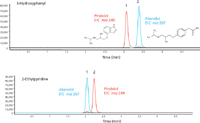
Figure 3
Size-Exclusion Chromatography
In the past few years, only a few new SEC columns have been introduced at Pittcon. That doesn't mean that SEC is not a highly practiced separation mode. It is a standard technique for the separation and characterization of organic polymers, both organic- and water-soluble. In addition, the mode is widely used for the separation of proteins and other biopolymers, sometimes known as gel filtration chromatography. Only two companies (Waters and Sepax) introduced columns for SEC at Pittcon 2012. The majority of the columns were recommended for the separation of biomolecules, but some can be used for nonbiological water-soluble polymers too.
The Waters offering was an aqueous SEC column based on their 1.7-µm bridged ethylene hybrid (BEH) particle Acquity UPLC BEH125 SEC technology. The pore size of this porous packing is 125 Å, making it suitable for most peptides and proteins from 1000 to 80,000 Da and thus complementing their BEH200 SEC product designed for high-molecular-weight proteins up to 450 kDa. For the surface of the packing to be biocompatible, a hydrophilic moiety must be introduced. Waters used a proprietary diol coating. An advantage of this hydrophilic surface is that it reduces the requirement of high salt concentrations in the mobile phase to cut down on undesired, secondary analyte–particle interactions. Analytical columns (150 mm × 4.6 mm) and a guard column (30 mm × 4.6 mm) are available.
Sepax Technologies is a company that specializes in biocolumns. This year, they introduced two new column lines and a protein screening kit. Like Waters, one of their introductions was the sub-2-µm Unix SEC-200 aqueous SEC packing. The average particle diameter is 1.8 µm and the pore size is 200 Å. Three column dimensions (with stainless steel construction to hold up to the high pressure) were shown at Pittcon: 250 mm and 300 mm × 4.6 mm for analytical work, and a 150 mm × 7.8 mm size for semipreparative applications. The surface of their packing has a hydrophilic, neutral, nanometer-thick coating. This column is recommended for peptides and proteins with a molecular weight range from 1 kDa to 500 kDa. Their second column introduction (Zenix SEC-80) had a similar chemistry but the pore size was only 80 Å and the particle size is 3 µm. Both stainless steel and PEEK versions are available. Standard dimensions are 300 mm × 2.1, 4.6, and 7.8 mm; guard columns of 50 mm × 4.6 mm and 50 mm × 7.8 mm are available. Other dimensions can be custom ordered. The Zenix column is recommended for the size separation of peptides and small proteins (up to 20 kDa) and has also found use to fractionate complex peptide mixtures as the first-dimension column in a multidimensional column setup. The columns are compatible with a wide variety of mobile phases including trifluoroacetic acid–acetonitrile and methanol mixtures.
The Sepax Screening Kit consists of two hydrophilic, neutral, nanometer-thick film columns, one called Zenix, a mechanically stabilized 3-µm silica with a "stand-up" bonded monolayer, and Zenix-C with a "lay-down" monolayer on porous 3-µm silica. The two columns are designed to complement each other and provide different secondary interactions. The SEC columns (300 mm × 7.8 mm) are recommended for the screening of monoclonal antibodies, hydrophobic proteins, pegylated peptides, proteins, oligonucleotides, bacteria, and viruses.
Specialty HPLC Columns
Specialty columns are HPLC columns that have been developed for specific separations that are difficult to achieve on a standard column. However, sometimes manufacturers will use a standard column but test it specifically for a certain class or compounds and provide a recommended set of chromatographic conditions. In some cases, the specialty column comes as part of a "total solution" kit with reagents, standards, and a method. Most specialty columns will be delivered with a test chromatogram from an analysis performed at the factory before shipment and some are guaranteed for a specific separation. Table IV shows the 18 specialty columns that were presented at Pittcon this year. Silica gel–based columns dominated the introductions, but polymer-based specialty columns and packings were also introduced.
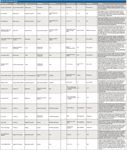
Table IV: HPLC specialty columns
As shown in Table IV, three main application areas dominated the specialty column introductions: proteins, particularly monoclonal antibodies; chiral; and ion chromatography–ion exchange, particularly for environmental compounds. The monoclonal antibody columns were based on multiple separation modes (cation exchange, reversed phase, size exclusion, and affinity). For many years, the study of monoclonal antibodies has been a hot area in the potential development of biopharmaceuticals for diagnostics and clinical uses. A number of monoclonal antibody–based drugs has been approved by the U.S. Food and Drug Administration. Another popular technique for protein purification is hydrophobic interaction chromatography (HIC). GE Healthcare Life Sciences expanded its line of Capto media to include new hydrophobic phases for HIC.
Chiral separations are still in the forefront, especially in the pharmaceutical industry. Four new chiral HPLC columns were introduced at Pittcon 2012 (Table IV), based on modified cellulose (polysaccharide) and protein phases. Because many analytical separations are scaled up to obtain larger quantities of purified enantiomers, preparative particle sizes frequently are part of column introductions, hence some particles as large as 20 µm were displayed.
Dionex, now part of Thermo Fisher Scientific, continued its yearly introductions of ion chromatography columns for environmental and life science applications. Their base material, a co-polymer consisting of ethylvinylbenzene crosslinked with 55% divinylbenzene (DVB–EVB), has served them well for many years. This year they have incorporated an alkanol quaternary ammonium group and have used it to separate haloacids in drinking water using a two-dimensional ion chromatography setup.
Often in LC, users avoid having mixed separation mechanisms because sometimes it is difficult to predict analyte retention changes with changes in mobile phase composition and temperature. On the other hand, mixed mechanisms can sometimes aid in obtaining a particularly difficult separation. Basic compounds can be particularly troublesome in reversed-phase separations. Imakt USA of Philadelphia, a subsidiary of the Japanese company Imakt Corporation, in Kyoto, Japan, introduced two mixed-mode phases that consist of a C18 phase with various amounts of cationic and anion ligands on the surface. The Scherzo SS-C18 phase has a large amount of strong ionic ligands and is effective for improved retention of zwitterions or weak ionic compounds. The Scherzo SW-C18 phase has a C18 functionality plus a low amount of strong ionic ligands (Figure 4a). It is more effective for the separation of strong ionic compound elution or basic compounds with formic acid eluent. Figure 4c shows the latter phase used under different chromatographic conditions for the separation of some basic drugs. Note the differences in the separation using acidic conditions versus neutral conditions.
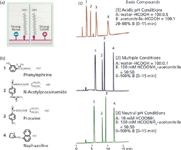
Figure 4
Acknowledgment
I would like to thank the manufacturers and distributors that kindly furnished the requested information in advance of Pittcon 2012, thus allowing a timely report on new product introductions. Manufacturers who would like to be considered for inclusion into Pittcon 2013 coverage should send the name of the primary company contact, the mailing address, phone number and e-mail address to Laura Bush, Editor, LCGC North America, lbush@advanstar.com, with the subject line, "Pittcon 2013 Column Watch."
Ronald E. Majors "Column Watch" Editor Ronald E. Majors is Senior Scientist, Columns and Supplies Division, Agilent Technologies, Wilmington, Delaware, and is a member of LCGC's editorial advisory board. Direct correspondence about this column via e-mail to lcgcedit@lcgcmag.com.

Ronald E. Majors
References
(1) R.E. Majors, LCGC No. America 29(3), 218–235 (2011).
(2) R.E. Majors, LCGC No. America 29(4), 300–316 (2011).
(3) R.E. Majors, LCGC No. America 30(1) 20–34 (2012).
(4) R.E. Majors, LCGC No. America 25(5) 436–446 (2007).
(5) S.J. Lehotay, M. Anastassiades, and R.E. Majors, LCGC No. America 28(7), 504–516 (2010).
(6) R.E. Majors, LCGC No. America 29(1), 14–27 (2011).

Perspectives in Hydrophobic Interaction Temperature- Responsive Liquid Chromatography (TRLC)
TRLC can obtain separations similar to those of reversed-phase LC while using only water as the mobile phase.

.png&w=3840&q=75)

.png&w=3840&q=75)



.png&w=3840&q=75)



.png&w=3840&q=75)





